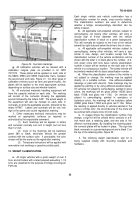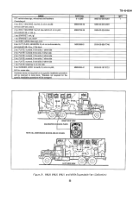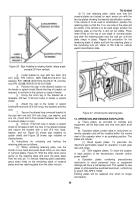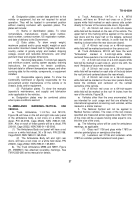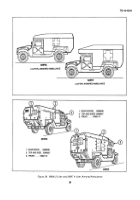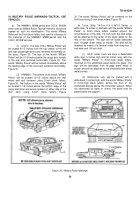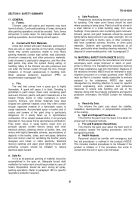TB-43-0209 - Page 37 of 406
TB 43-0209
19. CONTROL MEASURES
a.
Personal Protection
.
(1)
Personal Protection Equipment (PPE) used
in conjunction with respiratory protection equipment
(paragraph 19b) includes cloth coveralls, eye protection,
and head coverings. Cloth gloves are suitable unless
cellosolve acetate (2-ethoxyethyl acetate) is present in
the paint, solvent, or primer. When this solvent is
present, silicon rubber gloves are recommended. Spot
painters applying paint by brush or roller must wear
clothing and gloves affording full skin coverage.
Persons
who clean mixing and painting accessories should wear
eye protection and rubber gloves to preclude solvent
absorption and defatting of the hands caused by the
thinner.
(2)
The use of barrier creams is acceptable;
however, their usefulness in preventing the absorption of
solvent through the skin is not documented. If a solvent
with a skin notation is being used, then silicon rubber
gloves must be used. Barrier creams are useful in
preventing paint from adhering to the skin and in
combating the "dryness" associated with the defatting
action of most solvents. Solvents must never be used to
remove paint/coating from the skin.
(3)
Work clothing should be provided. After
completing painting or sanding operations, hygienic
showers should be taken prior to changing into street
clothing.
b.
Respiratory Protection
.
NOTE
For
the
purpose
of
determining
respiratory
protection required for a given operation, a confined
space is any of the following sites:
•
Any area where dilution ventilation cannot take
place, or where airflow is obstructed
•
Under or in vehicles/equipment, whether indoors
or outdoors
•
Indoor areas (not in spray paint booth) of less
than 10,000 cubic feet
•
Indoor areas where ceiling height is less than 16
feet a
•
Touchup paint areas with partitions, balconies,
or any structural barriers obstructing cross-
ventilation
•
Any area where outside air is not mechanically
distributed at a minimum rate of 3.5 cfm per
square foot of bay/room/area where touchup
painting takes place
(1) Spray Painting Indoors. An approved airline
respirator is the standard respirator to be worn when
paint spraying indoors; however, alternatives are
permitted when spray operations are not conducted in a
confined space and valid sampling results document the
personal exposure levels.
(a)
Large Vehicular or Walk-in Booths. If the
diisocyanate concentration is below the standard, a full
facepiece chemical cartridge respirator with a paint
prefilter is adequate. If the solvent concentration is less
than 10 times the standard, a paint-spray respirator is
adequate. If the pigment containing lead or chromate
concentration is less than 10 times the standard, an
organic vapor respirator with a HEPA filter is adequate.
(b)
Spray Cabinet or Conveyor-type Booth. If
the contaminant (solvent, pigment, or diisocyanate)
concentration is below the standard, no respiratory
protection is required. If either the solvent or diisocyanate
concentration exceeds the standard, an airline respirator
is required. If the pigment containing lead or chromate
concentration exceeds the standard, but is less than 10
times the standard, an organic vapor respirator with a
HEPA filter is required.
(c)
Spray Painting Outdoors. If in a confined
space, an airline respirator is required. If not in a
confined space, a paint-spray respirator is required.
(2) Brush or Roller Painting Indoors or Outdoors. If
not in confined space, an organic vapor respirator,
unless
deemed
unnecessary
by
preventive
medicine/industrial hygiene personnel. In a confined
space, an approved airline respirator is required.
Application of a water-base paint does not normally
require respiratory protection; however, local preventive
medicine/industrial hygiene personnel will determine the
requirements.
(3) All Painting. If respiratory protection other than
an approved airline respirator is used, then exposure
must be documented by preventive medicine/industrial
hygiene personnel.
(4) Sampling. Sampling is done during the painting
of different vehicles and equipment, when the booths’
filters are clean and dirty, when changes or modifications
occur in or to the booths, and for each painter. The
sampling will be performed according to the US Army
Environmental Hygiene Agency’s Technical Guide No.
141 and in sufficient numbers to be statistically valid.
Sampling methods other than those listed in the Tech
Guide, i.e., NIOSH methods, may be used upon approval
by the laboratory providing services. The documentation
will be revalidated every 2 years if the initial sampling
results are below one-half of the standard and every 6
months if greater than one-half of the standard.
Additional monitoring is required whenever there has
been a production, process, control or personnel change
or whenever there is any other change that may result in
new or additional exposures.
32
Back to Top

